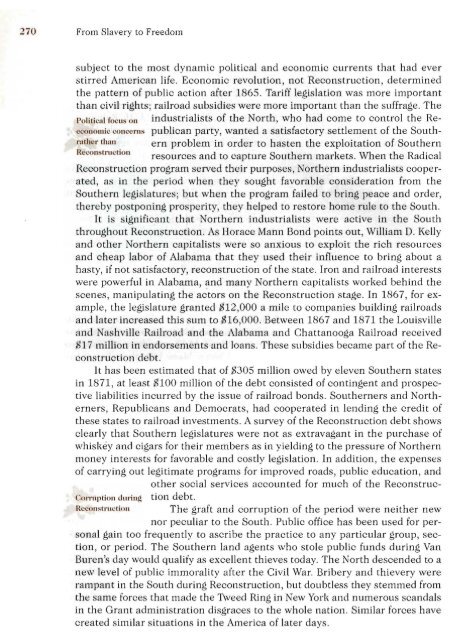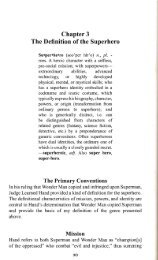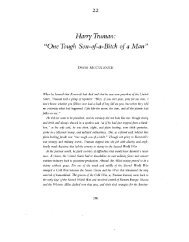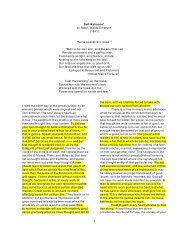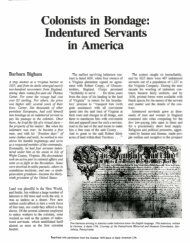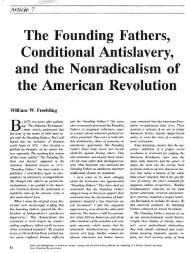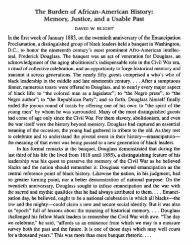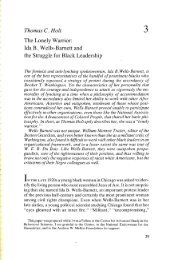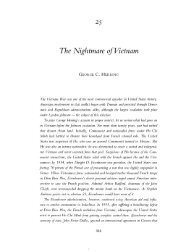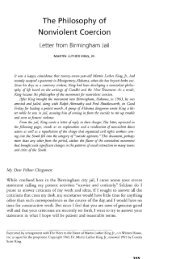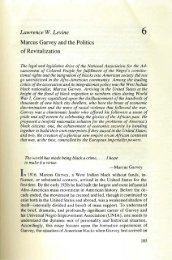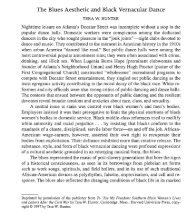Mary - Journeytohistory
Mary - Journeytohistory
Mary - Journeytohistory
You also want an ePaper? Increase the reach of your titles
YUMPU automatically turns print PDFs into web optimized ePapers that Google loves.
270 From Slavery to Freedomsubject to the most dynamic political and economic currents that had everstirred American life. Economic revolution, not Reconstruction, determinedthe pattern of public action after 1865. Tariff legislation was more importantthan civil rights; railroad subsidies were more important than the suffrage. ThePoliticol f cus on industrialists of the North, who had come to control the ReeconomicCOllccms publican party, wanted a satisfactory settlement of the South,·othcrlluUl ern problem in order to hasten the exploitation of SouthernReconstmction resources and to capture Southern markets. When the RadicalReconstruction program served their purposes, Northern industrialists cooperated,as in the period when they sought favorable consideration from theSouthern legislatures; but when the program failed to bring peace and order,thereby postponing prosperity, they helped to restore home rule to the South.It is significant that Northern industrialists were active in the Souththroughout Reconstruction. As Horace Mann Bond points out, William D. Kellyand other Northern capitalists were so anxious to exploit the rich resourcesand cheap labor of Alabama that they used the'ir influence to bring about ahasty, if not satisfactory, reconstruction of the state. Iron and railroad interestswere powerful in Alabama, and many Northern capitalists worked behind thescenes, manipulating the actors on the Reconstruction stage. In 1867, for example,the legislature granted $12,000 a mile to companies building railroadsand later increased this sum to $16,000. Between 1867 and 1871 the Louisvilleand Nashville Railroad and the Alabama and Chattanooga Railroad received$17 million in endorsements and loans. These subsidies became part of the Reconstructiondebt.It has been estimated that of $305 million owed by eleven Southern statesin 1871, at least $100 million of the debt consisted of contingent and prospectiveliabilities incurred by the issue of railroad bonds. Southerners and Northerners,Republicans and Democrats, had cooperated in lending the credit ofthese states to railroad investments. A survey of the Reconstruction debt showsclearly that Southern legislatures were not as extravagant in the purchase ofwhiskey and cigars for their members as in yielding to the pressure of Northernmoney interests for favorable and costly legislation. In addition, the expensesof carrying out legitimate programs for improved roads, public education, andother social services accounted for much of the ReconstrucCnrruptioll duriJJg tion debt.HcconStl11ction The graft and corruption of the period were neither newnor peculiar to the South. Public office has been used for personalgain too frequently to ascribe the practice to any particular group, section,or period. The Southern land agents who stole public funds during VanBuren's day would qualify as excellent thieves today. The North descended to anew level of public immorality after the Civil War. Bribery and thievery wererampant in the South during Reconstruction, but doubtless they stemmed fromthe same forces that made the 1\veed Ring in New York and numerous scandalsin the Grant administration disgraces to the whole nation. Similar forces havecreated similar situations in the America of later days.


